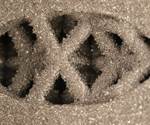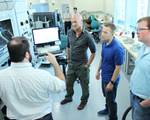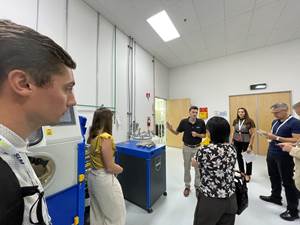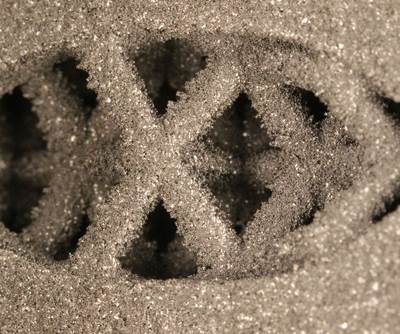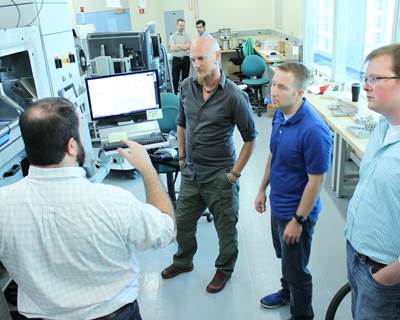Video: The Impact of Part Orientation on Cost and Build Time in AM
A different build orientation might mean fewer layers and less support structure, though the part might need to be redesigned to take advantage of this different orientation.
In this video, Professor Timothy Simpson of Penn State University discusses with me the case of a 3D-printed part in which just turning the part to a different orientation offered the chance to save considerable cost and time. Laying the part on its side meant fewer layers and less support structure might be needed. But first, the part had to be redesigned so it could build effectively in this orientation and so support structures could be removed. Design for additive manufacturing (DFAM) includes consideration such as these.
A co-director of the Center for Innovative Materials Processing Through Direct Digital Deposition (CIMP-3D) at Penn State, Dr. Simpson is a regular contributor to our site. He is also part of the faculty of a graduate-level program in AM.
Transcript
Peter Zelinski, Additive Manufacturing
I'm Pete Zelinski with Additive Manufacturing magazine, and I am here with Dr. Tim Simpson, co-director of the Center for Innovative Materials Processing Through Direct Digital Ddeposition at Penn State University. Tim, we have a metal additive part here, a 3D-printed part. What's the material?
Tim Simpson, PSU
Titanium.
Peter Zelinski
All right, a titanium part. And we'll talk about the straightforward question of build orientation, which in a lot of ways isn't so straightforward at all. This part was built [and] oriented like this. It took a lot of build time, and the time was just part of the waste. Talk about that.
Tim Simpson
Correct. So, this was actually an upright for the Formula race car team here at Penn State, Vincent Miranda was working with my colleague, Todd Palmer, to design and optimize this. They had used topology optimization to create this very lightweight structure and EOS was printing for us at the time, and decided to orient it in this direction. One of the challenges with this now is you've got overhanging and support surfaces here that need support structures. So in the end, printing it vertically, like this, took 54 hours to build, of which about 30 hours of that was to create the supports. And it was about $2,000 in powder. $1,500 was in the support structure. So, over half of your build time and three quarters of your cost end up being scrapped and get removed from the actual part itself.
Peter Zelinski
All right, so a solution: Build it this way, orient it this way, and it's not as high up off of the build platform. Fewer layers ultimately to define the form, less time, why not do it this way?
Tim Simpson
Absolutely. So in most cases, you're absolutely right. The build height determines how long it takes and, of course, how much material it takes. This was done in a powder-bed fusion system, so that's a lot of titanium. So naturally, you would want to lay it flat in this orientation [with] minimum height as well as minimum build time. But then you now start to get these geometries underneath here that are going to need support structures, and it's going to be difficult, if not impossible, to be able to get in there and remove the support material to create that lightweight structure. So, you spent all this time optimizing your design, you're going to print it out, and then you've got extra material in there that you can't remove. That's just going to increase the weight again. So in this case, it didn't make sense to lay it down flat, given this geometry that we were trying to create.
Peter Zelinski
So you took it farther than this. What's the solution that did allow this orientation?
Tim Simpson
If you think about it, most of the topology optimization software out there now, essentially the computer program or algorithms that are helping you optimize these lightweight structures, they're not aware, they're not thinking about overhangs and support and build orientation. A lot of people are working on that, but it's not available yet.
We actually had a graduate student of mine that picked this up and continued the project, combining different optimization algorithms, as well as build planning software to identify, "Hey, can we sort of lightweight some of these over if we're going to print it in this orientation? How do we change some of this geometry and change some of the structure so that it still maintains the structural integrity as needed, but doesn't require as much support structures when it's being built?"
This is actually the end result there. What we've done is actually eliminated the caps, if you will, that are over that particular part; they don't need to be solid like that. We can lightweight it and then remove some material, but then we add some stiffening ribs in here to be able to do that, very small support structures now that would be easy to go in, pop out or move out as part of that. We're able to also, underneath here, change this geometry a little bit to make it slightly lighter weight. So we're able to now, as we design for additive manufacturing, think not only about the geometry, but also how are you going to build that, and the interaction between those two to try and create a lightweight structure that also doesn't need as much support structure as the parts being built.
Peter Zelinski
Design for additive manufacturing. So we hear that phrase, your university has a degree program in additive manufacturing and design. Design for additive manufacturing, we think about things like organic forms and topology optimization and lattice structures for weight savings. But another crucial aspect of design, when it comes to additive, is support structures. How much of additive design involves thinking about the support of your part while it's growing?
Tim Simpson
Absolutely. So I think when we're talking about design for additive, it's as much about designing the part as it is to think about or design the build itself. Those two decisions are very, very tightly coupled now and I think that's one of the challenges with design for additive manufacturing.
I think that's one of the challenges with design for additive manufacturing. We're having to make these new trade-offs that we're not used to making, [and] we don't have the software tools combined together yet to help us make those trade-offs.
We're having to make these new trade-offs that we're not used to making, [and] we don't have the software tools combined together yet to help us make those trade-offs. So for instance, as we said, thinking about what is my build orientation, as I'm creating my structure that then is going to dictate supports, [and] where I might need support (thin wall structures, maybe thick sections). All of those are important when we're starting to do the build planning, and we need to design and make decisions there just like we do in the geometry of the file itself.
Related Content
8 Cool Parts From Formnext 2023: The Cool Parts Show #65
New additive manufacturing technologies on display at Formnext were in many cases producing notable end-use components. Here are some of the coolest parts we found at this year’s show.
Read MoreUnderstanding PEKK and PEEK for 3D Printing: The Cool Parts Show Bonus
Both materials offer properties desirable for medical implants, among other applications. In this bonus episode, hear more from Oxford Performance Materials and Curiteva about how these companies are applying PEKK and PEEK, respectively.
Read MoreThe AM Ecosystem, User Journeys and More from Formnext Forum Austin: AM Radio #43
Sessions and conversations at the first U.S. Formnext event highlighted the complete additive manufacturing ecosystem, sustainability, the importance of customer education, AM user journeys and much more.
Read More3D Printing with Plastic Pellets – What You Need to Know
A few 3D printers today are capable of working directly with resin pellets for feedstock. That brings extreme flexibility in material options, but also requires greater knowledge of how to best process any given resin. Here’s how FGF machine maker JuggerBot 3D addresses both the printing technology and the process know-how.
Read MoreRead Next
Options for Finishing and Postprocessing Metal 3D-Printed Parts
There is a host of technologies available for finishing and postprocessing your AM parts. This column identifies options beyond machining.
Read MoreInside the Penn State Additive Manufacturing Master’s Program, Part 1
PSU's engineering master's degree in additive manufacturing and design offers students and manufacturing professionals a higher education in a continuously maturing field.
Read MoreAlquist 3D Looks Toward a Carbon-Sequestering Future with 3D Printed Infrastructure
The Colorado startup aims to reduce the carbon footprint of new buildings, homes and city infrastructure with robotic 3D printing and a specialized geopolymer material.
Read More

